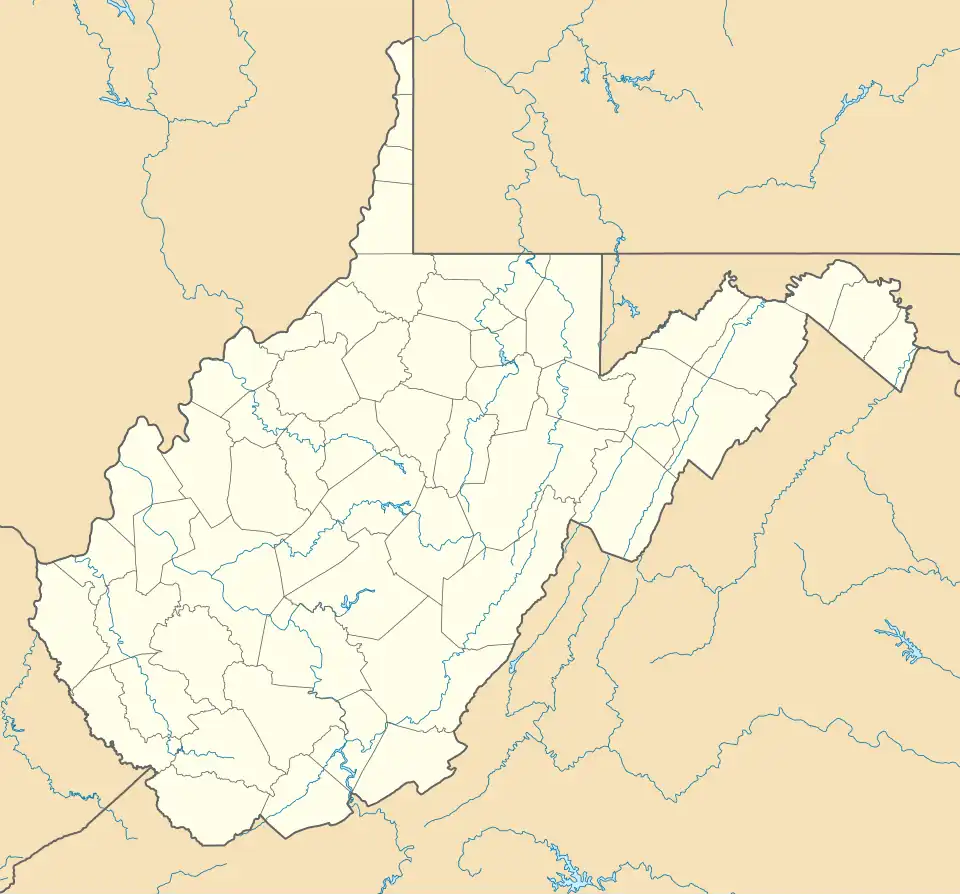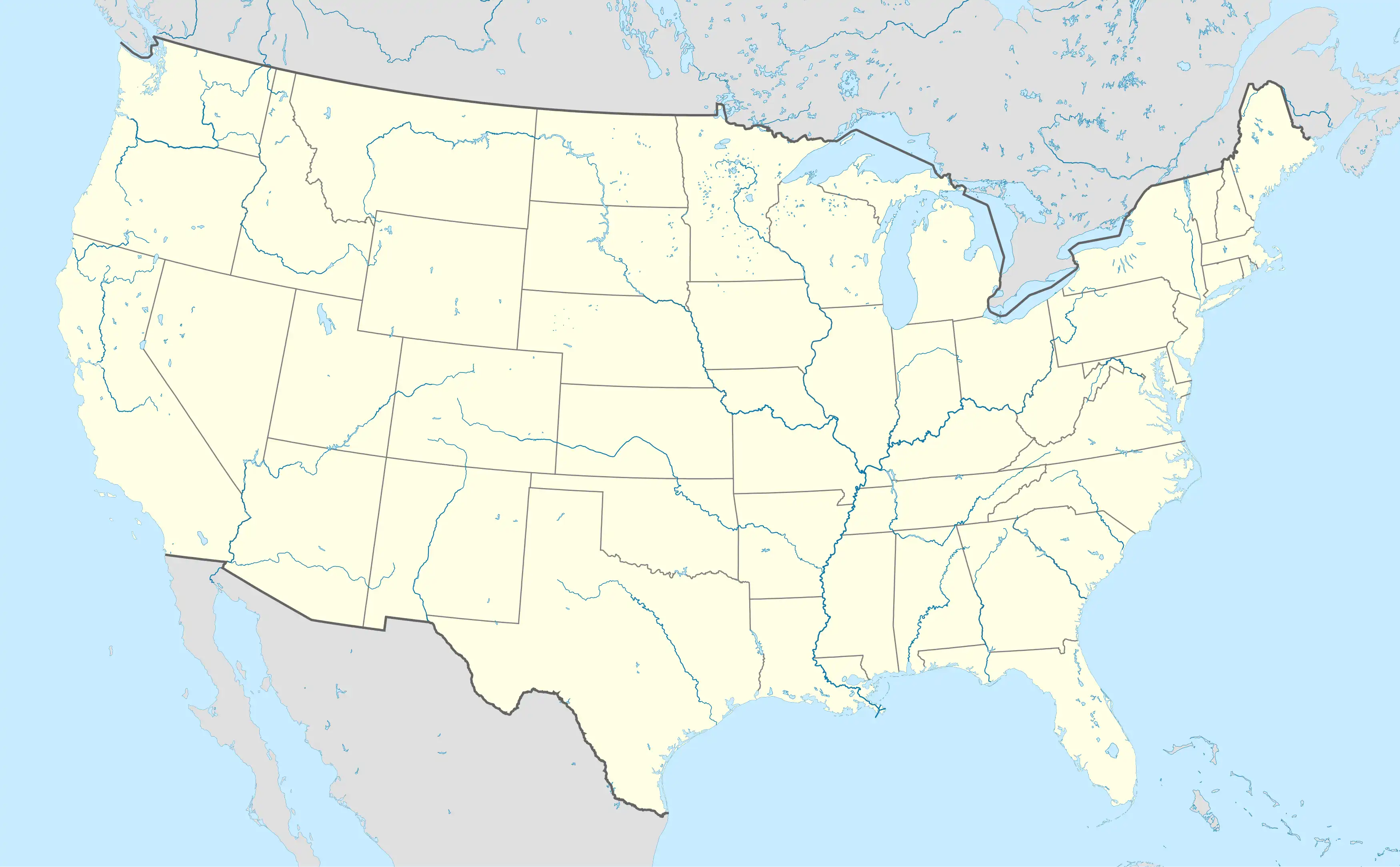Zion Episcopal Church (Charles Town, West Virginia)
| Zion Episcopal Church | |
|---|---|
| Zion Episcopal Church, Saint Andrews Parish[1] | |
 Photograph taken c. 1900 | |
   | |
| 39°17′20.1″N 77°51′20.6″W / 39.288917°N 77.855722°W | |
| Location | 301 East Congress Street Charles Town, West Virginia |
| Country | United States |
| Denomination | Episcopal Church |
| Website | www |
| History | |
| Consecrated | December 6, 1851[1] |
| Architecture | |
| Architectural type | Gothic Revival[2] |
| Years built | 1815 (first church) 1847–8 (second church) 1851 (present church)[1][3] |
| Clergy | |
| Rector | Johanna Marcure[4] |
Zion Episcopal Church | |
| Part of | Downtown Charles Town Historic District (ID97000263[5]) |
| Added to NRHP | March 21, 1997[5] |
Zion Episcopal Church is a historic Episcopal church in Charles Town, in the U.S. state of West Virginia.
Geography and setting
Zion Episcopal Church is located on the highest point in Charles Town, on East Congress Street, between Mildred and Church Streets.[1][2] Due to its elevation, the church was named Zion, meaning "city on the hill, the heavenly Jerusalem."[3]
History
Episcopalian residents in the area of present-day Charles Town were originally served by St. Georges Chapel, which was built in the 1770s and fell into disrepair following the American Revolutionary War.[1][6] In 1815, the first church building on the site of Zion Episcopal Church was established and built as a successor to St. Georges Chapel.[1][3][6] This church was replaced by a larger structure built between 1847 and 1848; however, this church was destroyed by fire shortly after its completion.[1] In 1851, the present church was built and consecrated on December 6 of that year.[1][7]
During the American Civil War, the church was used by Union forces as a hospital for Union troops, during which time the building sustained significant damage.[3]
On March 21, 1997, the Downtown Charles Town Historic District was listed on the National Register of Historic Places, which includes Zion Episcopal Church as a contributing property.[2][5]
Architecture
The Zion Episcopal Church is a brick building built in the Gothic Revival architectural style.[2] The church features a square bell tower, decorative corbeling, and multi-paned windows with pointed arched heads.[2]
Churchyard
The churchyard contains over 1,500 gravesites, including the interments of 70 members of the Washington family, more than any other site in the United States outside Mount Vernon.[3] The following notable individuals are interred in the churchyard:
- John Yates Beall, Confederate privateer in the American Civil War[8][9][10]
- R. Preston Chew, Businessperson and politician[8]
- William Price Craighill, Union Army officer[11]
- William Loyall Gravatt, American Episcopal bishop[12]
- Thomas C. Green, Supreme Court of Appeals of West Virginia justice[13]
- Andrew Hunter, American lawyer and politician
- Andrea King, American actor
- Daniel B. Lucas, Supreme Court of Appeals of West Virginia justice[14]
- William Lucas, American politician[15]
- Beverley D. Tucker, American Episcopal bishop[8]
- Bushrod C. Washington, American politician
- Lewis Washington, John Brown's raid on Harpers Ferry hostage[10]
See also
References
- ^ a b c d e f g h "Zion Episcopal Church: More History". Zion Episcopal Church. 2020. Retrieved July 26, 2025.
{{cite web}}: CS1 maint: url-status (link) - ^ a b c d e Reed 1997, p. 24 of the PDF file.
- ^ a b c d e Smith, Robert (April 18, 2012). "Zion Episcopal Church". Spirit of Jefferson. Charles Town, West Virginia. Retrieved July 26, 2025.
- ^ "Zion Episcopal Church: Staff". Zion Episcopal Church. 2020. Retrieved July 26, 2025.
{{cite web}}: CS1 maint: url-status (link) - ^ a b c "National Register of Historic Places Digital Archive on NPGallery: Downtown Charles Town Historic District". National Park Service. 2025. Retrieved July 26, 2025.
{{cite web}}: CS1 maint: url-status (link) - ^ a b Peterkin 1902, p. 771.
- ^ Peterkin 1902, p. 136.
- ^ a b c "Zion Episcopal Churchyard: Map". Zion Churchyard. 2020. Retrieved July 26, 2025.
{{cite web}}: CS1 maint: url-status (link) - ^ Bushong 1941, pp. 187 & 278.
- ^ a b Stewart, Bill (January 23, 1964). "Jefferson County Burial Lore". The Morning Herald. Hagerstown, Maryland. p. 2. Retrieved July 26, 2025 – via NewspaperArchive.
- ^ Bushong 1941, p. 282.
- ^ "Gravatt Rites Slated Today: Retired Bishop and Wife Claimed by Death". Charleston Daily Mail. Charleston, West Virginia. February 15, 1942. p. 13. Retrieved July 26, 2025 – via NewspaperArchive.
- ^ "Judge Thomas C. Green" (PDF). Spirit of Jefferson. Charles Town, West Virginia. December 10, 1889. p. 3. Retrieved July 26, 2025 – via Chronicling America.
- ^ "Judge Daniel B. Lucas Dead" (PDF). Spirit of Jefferson. Charles Town, West Virginia. July 27, 1909. p. 2. Retrieved July 26, 2025 – via Chronicling America.
- ^ United States Congress 1950, p. 1481.
Bibliography
- Bushong, Millard Kessler (1941). A History of Jefferson County, West Virginia. Jefferson Publishing Company. Retrieved July 26, 2025 – via HathiTrust.
- Reed, Paula S. (February 18, 1997). National Register of Historic Places Registration Form: Downtown Charles Town Historic District (PDF). United States Department of the Interior, National Park Service; and West Virginia Department of Arts, Culture and History. Retrieved July 26, 2025.
- Peterkin, George William (1902). A History and Record of the Protestant Episcopal Church in the Diocese of West Virginia. Charleston, West Virginia: The Tribune Company, Printers. Retrieved July 26, 2025 – via Internet Archive.
- United States Congress (1950). Biographical Directory of the American Congress, 1774–1949. Washington, D.C.: Government Printing Office. Retrieved July 26, 2025 – via Internet Archive.